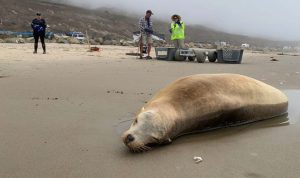Rapid-response HABs monitoring effort to help illuminate how toxin-producing blooms affect marine mammals

SCCWRP and its partners have helped mobilize and coordinate a rapid-response effort to collect offshore field sampling data on toxin-producing harmful algal blooms (HABs) in Southern California coastal waters, following a massive bloom event this summer that sickened or killed more than 500 marine mammals.
The new data set – collected during a toxin-producing Pseudo-nitzschia bloom that peaked in late June – is helping researchers build modeling tools for predicting when and where these disruptive events will occur, and for estimating how sea lions, dolphins and other marine animals will be affected. Pseudo-nitzschia blooms produce a neurotoxin known as domoic acid that can cause seizures, disorientation, beach strandings and even death.
During major bloom events, marine mammal rescue centers – which are mostly volunteer-driven operations – struggle to keep up with sudden, dramatic spikes in marine mammal strandings on beaches. Generally, about 40%-60% of all stranded mammals that are rescued can recover if administered appropriate anti-seizure medications and/or moved from populated beaches to local rehabilitation centers.
The rapid-response HABs monitoring effort has nearly doubled in size an offshore data set that was collected last year during a similarly disruptive bloom event. Because bloom events of this scale do not occur every year and do not unfold along a consistent timeline, researchers must rapidly mobilize sampling teams to collect offshore HABs data when opportunities arise.
In summer 2022 – during a bloom event that sickened more than 250 marine mammals in the Santa Barbara Channel area – SCCWRP helped rapidly mobilize four research cruises.
As soon as the bloom began in June 2023, SCCWRP helped train and mobilize seven research cruises that sampled in both the Santa Barbara Channel and Los Angeles County coastal waters. SCCWRP’s partners included the Southern California Coastal Ocean Observing System (SCCOOS), National Oceanic and Atmospheric Administration (NOAA), University of California, Santa Cruz, and members of California’s Marine Mammal Stranding Network.
Also as part of this rapid-response effort, SCCWRP developed marine HAB sampling kits and training resources to better support partners with HABs monitoring in the future.
Researchers will pair the bloom data sets with data collected by Southern California marine mammal centers on the numbers of mammals stranded along the coastline and how much domoic acid is found in their blood and urine.
The paired data sets will be used to refine a set of prototype modeling tools designed to predict the locations and severity of toxin-producing bloom events at the earliest possible stages. The tools can be used to help predict the likelihood of marine mammals becoming stranded on the beach as a result of neurotoxin exposure, enabling local rescue centers to mobilize their resources ahead of anticipated mass strandings.
Pseudo-nitzschia and other ecologically disruptive blooms are becoming increasingly commonplace and more intense as climate change intensifies.
Although California has been collecting HABs monitoring data for more than a decade via the Harmful Algal Bloom Monitoring and Alert Program (HABMAP), HABMAP targets nearshore coastal waters only. Offshore HABs monitoring data have the potential to complement HABMAP data, extending the data’s utility as an early-warning indicator of larger-scale bloom events. For example, the Pseudo-nitzschia blooms in 2022 and 2023 started further offshore.
For more information, contact Dr. Jayme Smith.
More news related to: Eutrophication, Harmful Algal Blooms, Top News